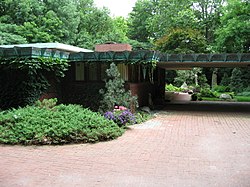Samara (house)
 From Wikipedia - Reading time: 11 min
From Wikipedia - Reading time: 11 min
John E. and Catherine E. Christian House (Samara) | |
 | |
| Location | West Lafayette, Indiana |
|---|---|
| Coordinates | 40°26′18.8″N 86°54′59.6″W / 40.438556°N 86.916556°W |
| Built | 1956 |
| Architect | Frank Lloyd Wright Frank Woods |
| Architectural style | Modern Movement |
| NRHP reference No. | 92000679 [1] |
| Significant dates | |
| Added to NRHP | June 16, 1992 |
| Designated NHL | February 27, 2015 |
Samara, also known as the John E. Christian House, is a house designed by Frank Lloyd Wright located in West Lafayette, Indiana. The home is an example of the Usonian homes that Wright designed. Samara was built from 1954 to 1956 and was still occupied by the original owner, John E. Christian, until he died on July 12, 2015.[2][3]
History
[edit]
In 1950 John and Kay Christian decided to build a home near Purdue University where they both worked, John as a pharmaceutical chemistry professor and Kay as the social director for the university. After much discussion, they decided that Wright was the architect who suited the ideals for their home. Not knowing how to proceed, John phoned Wright directly at his office and was surprisingly able to speak directly to the famed architect. Over the next six years they worked together both with meetings in West Lafayette, Indiana and at Taliesin, Wright's summer home in Spring Green, Wisconsin. The home was named after the samara, which Wright spotted on the property during his first visit. He worked a stylized design of chevron-shaped leaves throughout the design of the home including the clerestory windows, dining chairs and the living room rug.[3] These designs, nicknamed The Winged Seed, are located on the perforated upper windows and were also used on the Bachman-Wilson Usonian home. The house was built to entertain the family's college students; the living room was designed for 50 people. It featured a long couch and room for sitting on the stairs.[4]
The Christian family maintains the home according to the exacting specifications of its architect. As in many of the homes he designed, Wright specified or designed the entire environment, including the furniture, linens and landscaping. The Christians were not initially able to purchase all of the specified custom details; however, they made an agreement with Wright to continue adding to the home as their budget allowed.[3]
The color palette of furniture and design details is brighter and more saturated than other examples of Wright's architecture. This was prompted by Kay Christian who requested brighter colors against Wright's wishes. Wright was finally convinced by his wife, Olgivanna Lloyd Wright, who insisted that she would help the Christians with the color design.[5] The result was a palette of vibrant lime green, magenta, and purple combined with more subdued shades of orange, yellow, and beige (see image at left). The home was designated as a National Historic Landmark in 2015.[6] The nomination form[7] for the home provides a very detailed overview of the home with pictures and floor plans.[8] It was featured in a mid-2015 exhibit at the Portsmouth Art and Cultural Center.[4]
In 2020 $1 million in grants was acquired to make repairs.[9]
See also
[edit]References
[edit]- ^ "National Register Information System". National Register of Historic Places. National Park Service. 23 January 2007.
- ^ Wallace J. Rogers (2001). Frank Lloyd Wright's Samara Winged Seeds of Indiana. John E. Christian Family Memorial Trust. ISBN 1-931775-00-1.
- Kelly Roberts (13 July 2015). "West Lafayette man, original Frank Lloyd Wright homeowner dies". WISH TV. Retrieved 14 July 2015. - ^ a b c Cindy Davis Meixel (January 2014). "Building the Wright Dream". Mountain Home. Archived from the original on 2 November 2014. Retrieved 2 November 2014.
- National Park System Advisory Board. "Samara (John E. and Catherine E. Christian House)" (PDF). National Park Service. - ^ a b Bleiberg, Larry (7 June 2015). "10 Great: Frand Lloyd Wright Homes". USA Today.
- ^ George Pudlo (2 January 2012). "John Christian House - SAMARA - Frank Lloyd Wright, 1954". Wright Oak Park Tours.
Mrs. Christian insisted on having brighter colors in the house that Wright originally proposed. Olgivanna Wright finally convinced Wright to adjust the color palette by offering her assistance to Mrs. Christian with hue.
- ^ "Secretary Jewell, Director Jarvis Announce Five New National Historic Landmarks Highlighting America's Diverse Heritage". U.S. Department of the Interior. 15 April 2015. Retrieved 15 April 2015.
- ^ "National Historic Landmark Nomination" (PDF). National Park Service. Retrieved 15 April 2015.
- ^ "Spring 2014 Landmarks Committee Meeting and NHL Nominations" (PDF). National Park Service. Retrieved 15 April 2015.
- ^ "$1 million in grants to repair Frank Lloyd Wright house in West Lafayette".
- Storrer, William Allin. The Frank Lloyd Wright Companion. University Of Chicago Press, 2006, ISBN 0-226-77621-2 (S.375)
 KSF
KSF





